sensor CHRYSLER PT CRUISER 2009 1.G User Guide
[x] Cancel search | Manufacturer: CHRYSLER, Model Year: 2009, Model line: PT CRUISER, Model: CHRYSLER PT CRUISER 2009 1.GPages: 410, PDF Size: 5.24 MB
Page 269 of 410
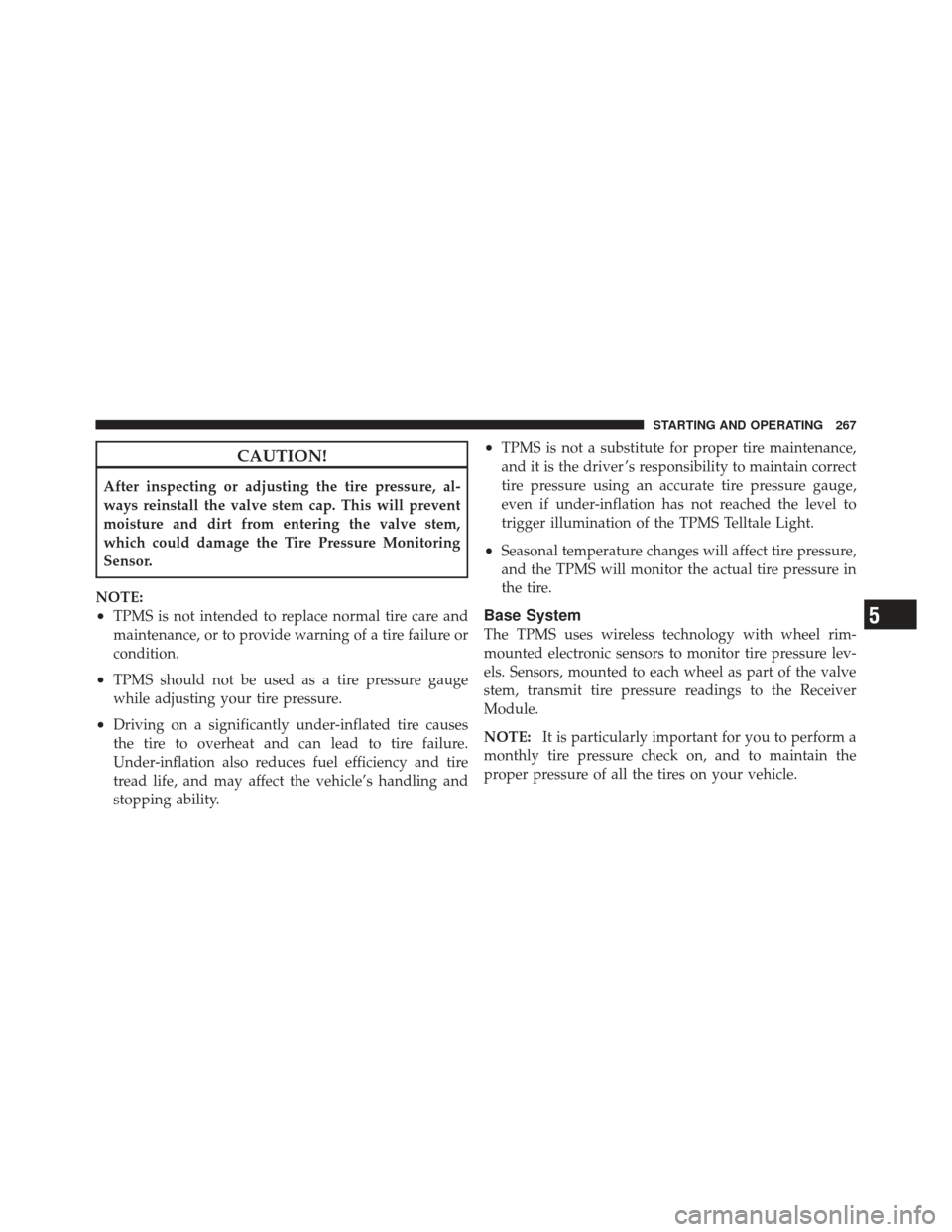
CAUTION!
After inspecting or adjusting the tire pressure, al-
ways reinstall the valve stem cap. This will prevent
moisture and dirt from entering the valve stem,
which could damage the Tire Pressure Monitoring
Sensor.
NOTE:
ãÂTPMS is not intended to replace normal tire care and
maintenance, or to provide warning of a tire failure or
condition.
ãÂTPMS should not be used as a tire pressure gauge
while adjusting your tire pressure.
ãÂDriving on a significantly under-inflated tire causes
the tire to overheat and can lead to tire failure.
Under-inflation also reduces fuel efficiency and tire
tread life, and may affect the vehicleãs handling and
stopping ability.
ãÂTPMS is not a substitute for proper tire maintenance,
and it is the driver ãs responsibility to maintain correct
tire pressure using an accurate tire pressure gauge,
even if under-inflation has not reached the level to
trigger illumination of the TPMS Telltale Light.
ãÂSeasonal temperature changes will affect tire pressure,
and the TPMS will monitor the actual tire pressure in
the tire.
Base System
The TPMS uses wireless technology with wheel rim-
mounted electronic sensors to monitor tire pressure lev-
els. Sensors, mounted to each wheel as part of the valve
stem, transmit tire pressure readings to the Receiver
Module.
NOTE: It is particularly important for you to perform a
monthly tire pressure check on, and to maintain the
proper pressure of all the tires on your vehicle.
5
STARTING AND OPERATING 267
Page 270 of 410
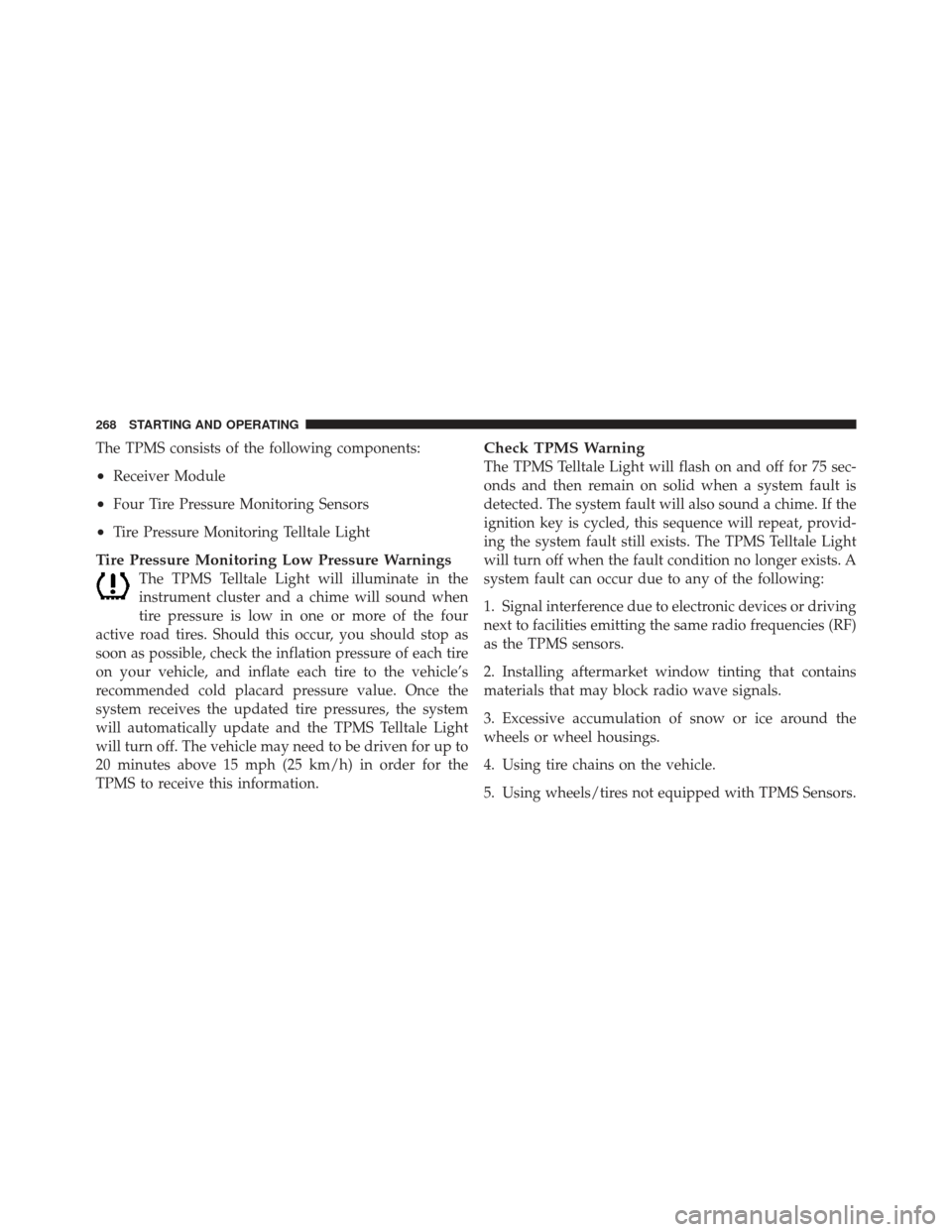
The TPMS consists of the following components:
ãÂReceiver Module
ãÂFour Tire Pressure Monitoring Sensors
ãÂTire Pressure Monitoring Telltale Light
Tire Pressure Monitoring Low Pressure Warnings
The TPMS Telltale Light will illuminate in the
instrument cluster and a chime will sound when
tire pressure is low in one or more of the four
active road tires. Should this occur, you should stop as
soon as possible, check the inflation pressure of each tire
on your vehicle, and inflate each tire to the vehicleãs
recommended cold placard pressure value. Once the
system receives the updated tire pressures, the system
will automatically update and the TPMS Telltale Light
will turn off. The vehicle may need to be driven for up to
20 minutes above 15 mph (25 km/h) in order for the
TPMS to receive this information.
Check TPMS Warning
The TPMS Telltale Light will flash on and off for 75 sec-
onds and then remain on solid when a system fault is
detected. The system fault will also sound a chime. If the
ignition key is cycled, this sequence will repeat, provid-
ing the system fault still exists. The TPMS Telltale Light
will turn off when the fault condition no longer exists. A
system fault can occur due to any of the following:
1. Signal interference due to electronic devices or driving
next to facilities emitting the same radio frequencies (RF)
as the TPMS sensors.
2. Installing aftermarket window tinting that contains
materials that may block radio wave signals.
3. Excessive accumulation of snow or ice around the
wheels or wheel housings.
4. Using tire chains on the vehicle.
5. Using wheels/tires not equipped with TPMS Sensors.
268 STARTING AND OPERATING
Page 271 of 410
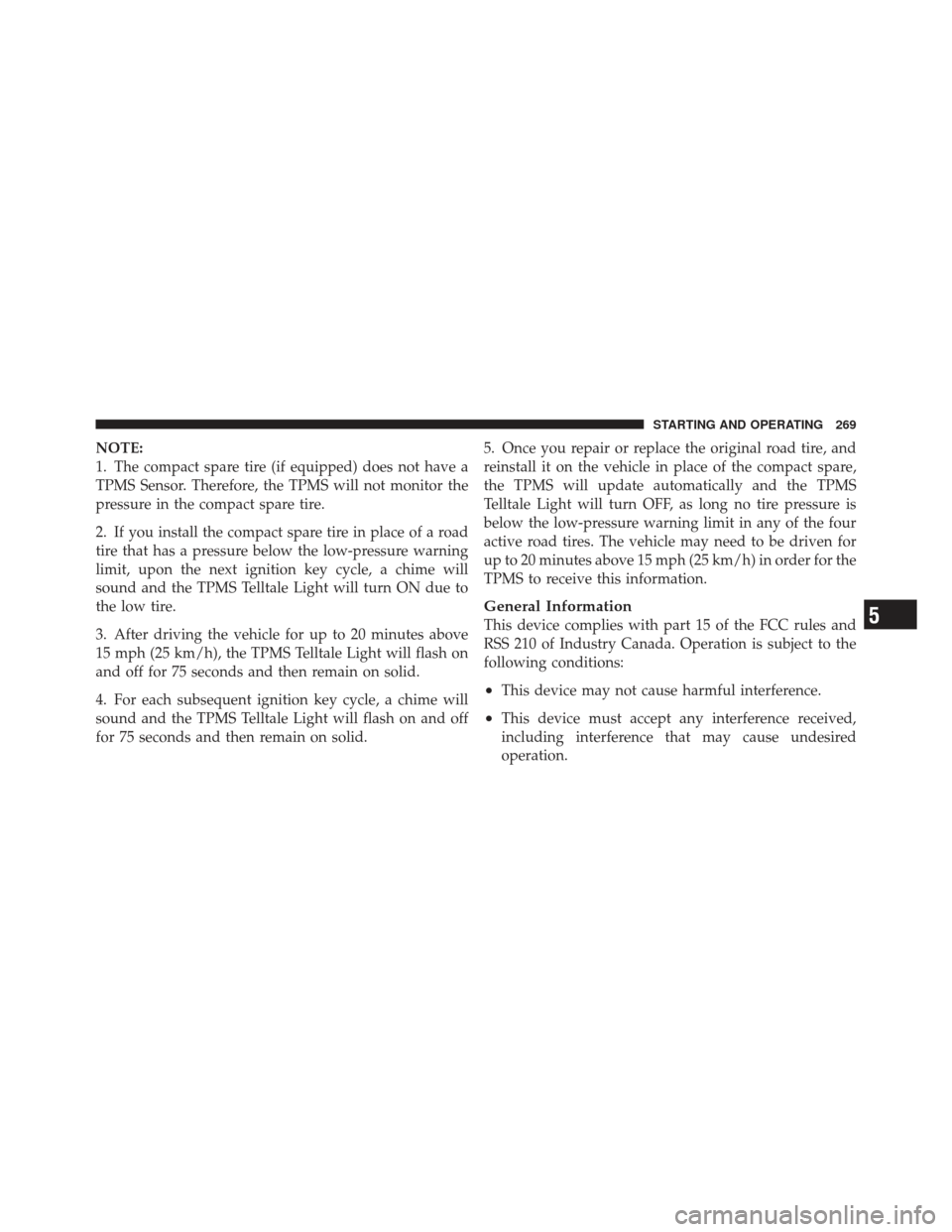
NOTE:
1. The compact spare tire (if equipped) does not have a
TPMS Sensor. Therefore, the TPMS will not monitor the
pressure in the compact spare tire.
2. If you install the compact spare tire in place of a road
tire that has a pressure below the low-pressure warning
limit, upon the next ignition key cycle, a chime will
sound and the TPMS Telltale Light will turn ON due to
the low tire.
3. After driving the vehicle for up to 20 minutes above
15 mph (25 km/h), the TPMS Telltale Light will flash on
and off for 75 seconds and then remain on solid.
4. For each subsequent ignition key cycle, a chime will
sound and the TPMS Telltale Light will flash on and off
for 75 seconds and then remain on solid.5. Once you repair or replace the original road tire, and
reinstall it on the vehicle in place of the compact spare,
the TPMS will update automatically and the TPMS
Telltale Light will turn OFF, as long no tire pressure is
below the low-pressure warning limit in any of the four
active road tires. The vehicle may need to be driven for
up to 20 minutes above 15 mph (25 km/h) in order for the
TPMS to receive this information.
General Information
This device complies with part 15 of the FCC rules and
RSS 210 of Industry Canada. Operation is subject to the
following conditions:
ãÂThis device may not cause harmful interference.
ãÂThis device must accept any interference received,
including interference that may cause undesired
operation.
5
STARTING AND OPERATING 269
Page 272 of 410
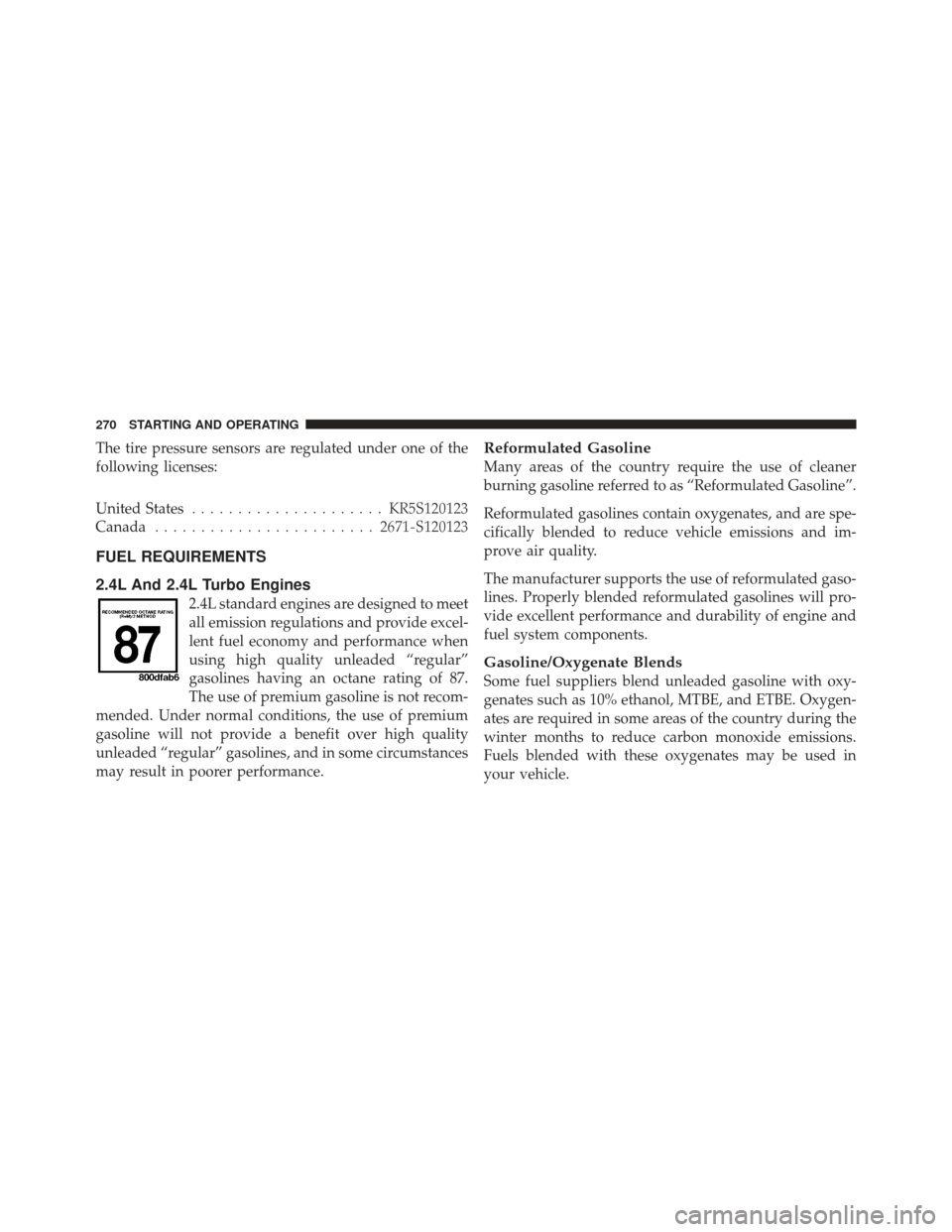
The tire pressure sensors are regulated under one of the
following licenses:
United States..................... KR5S120123
Canada ........................ 2671-S120123
FUEL REQUIREMENTS
2.4L And 2.4L Turbo Engines
2.4L standard engines are designed to meet
all emission regulations and provide excel-
lent fuel economy and performance when
using high quality unleaded ãregularã
gasolines having an octane rating of 87.
The use of premium gasoline is not recom-
mended. Under normal conditions, the use of premium
gasoline will not provide a benefit over high quality
unleaded ãregularã gasolines, and in some circumstances
may result in poorer performance.
Reformulated Gasoline
Many areas of the country require the use of cleaner
burning gasoline referred to as ãReformulated Gasolineã.
Reformulated gasolines contain oxygenates, and are spe-
cifically blended to reduce vehicle emissions and im-
prove air quality.
The manufacturer supports the use of reformulated gaso-
lines. Properly blended reformulated gasolines will pro-
vide excellent performance and durability of engine and
fuel system components.
Gasoline/Oxygenate Blends
Some fuel suppliers blend unleaded gasoline with oxy-
genates such as 10% ethanol, MTBE, and ETBE. Oxygen-
ates are required in some areas of the country during the
winter months to reduce carbon monoxide emissions.
Fuels blended with these oxygenates may be used in
your vehicle.
270 STARTING AND OPERATING
Page 344 of 410
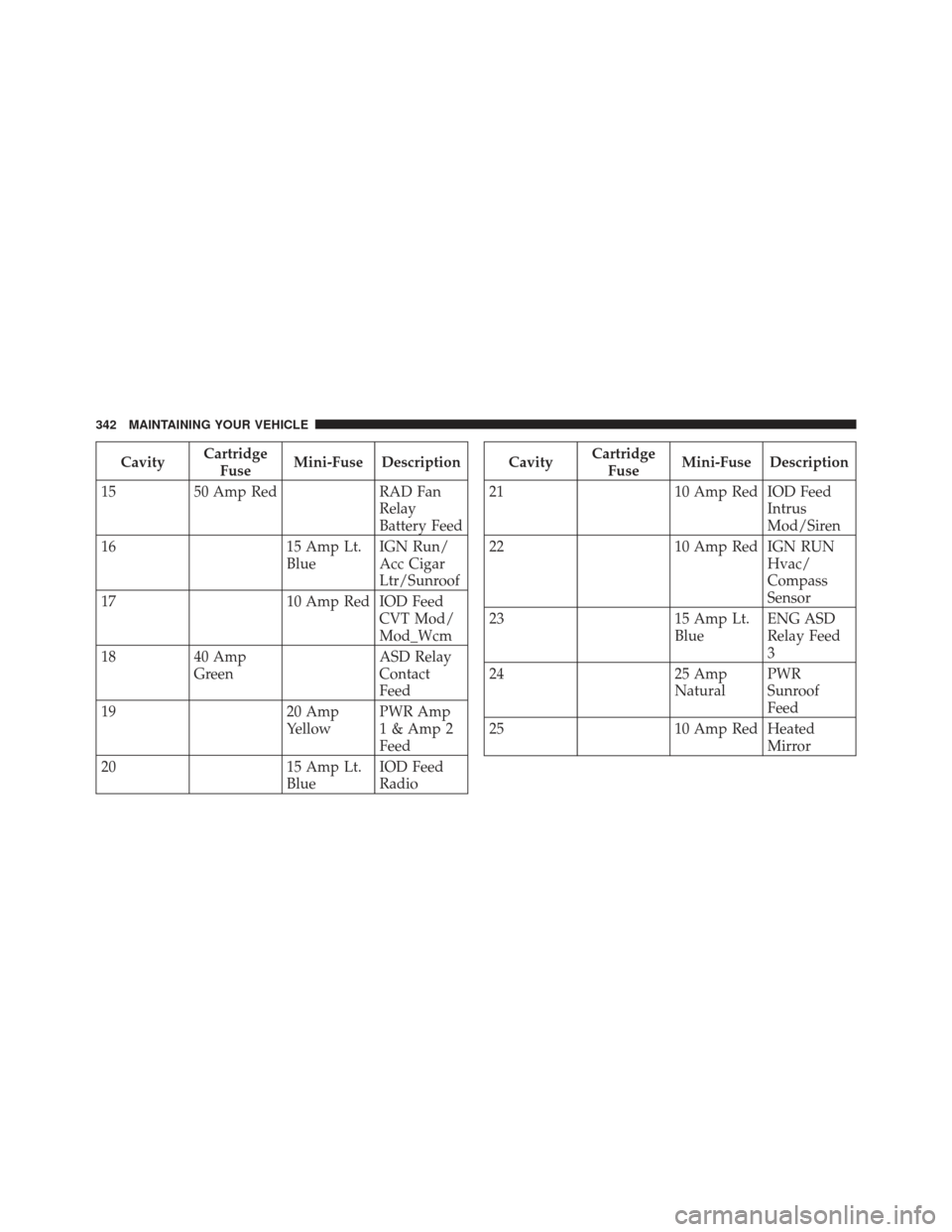
CavityCartridge
Fuse Mini-Fuse Description
15 50 Amp Red RAD Fan
Relay
Battery Feed
16 15 Amp Lt.
BlueIGN Run/
Acc Cigar
Ltr/Sunroof
17 10 Amp Red IOD Feed
CVT Mod/
Mod_Wcm
18 40 Amp
Green ASD Relay
Contact
Feed
19 20 Amp
YellowPWR Amp
1 & Amp 2
Feed
20 15 Amp Lt.
BlueIOD Feed
RadioCavity
Cartridge
Fuse Mini-Fuse Description
21 10 Amp Red IOD Feed
Intrus
Mod/Siren
22 10 Amp Red IGN RUN
Hvac/
Compass
Sensor
23 15 Amp Lt.
BlueENG ASD
Relay Feed
3
24 25 Amp
NaturalPWR
Sunroof
Feed
25 10 Amp Red Heated
Mirror
342 MAINTAINING YOUR VEHICLE